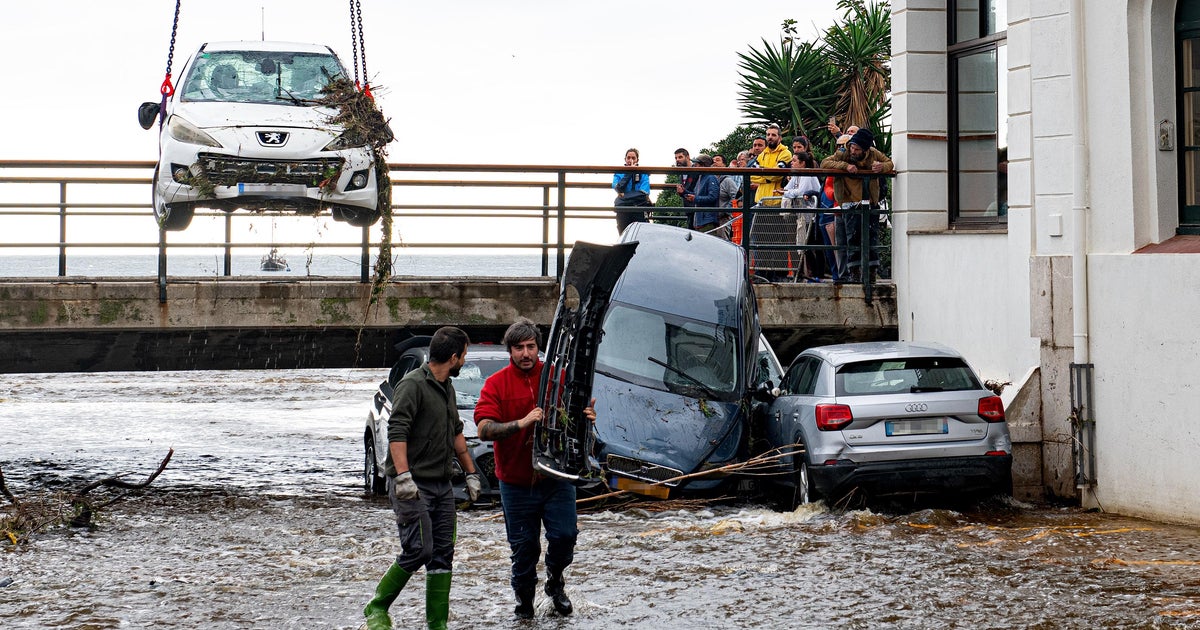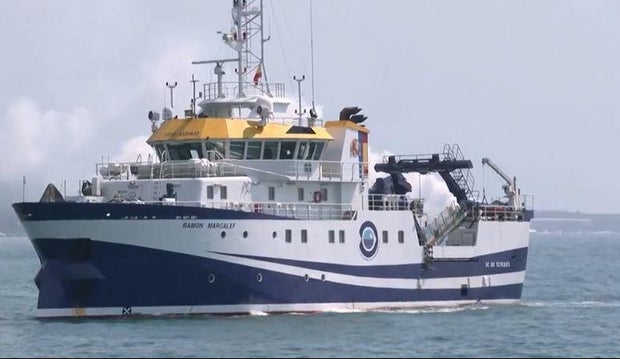CBS News
Spain sends research vessel to scan seafloor for Valencia victims as flash floods hit different region

Barcelona — A Spanish research vessel that investigates marine ecosystems has been abruptly diverted from its usual task to take on a new job: Helping in the increasingly desperate search for the missing from Spain’s deadly floods. As the dire work continued in the eastern province of Valencia to find the victims of the disaster and clean up the mess left behind, more torrential rain unleashed flash floods farther north along the coast, near Girona.
The 24 crew members aboard the Ramón Margalef were preparing Friday to use its sensors and submergible robot to map an offshore area of about 14 square miles — the equivalent of more than 5,000 soccer fields — to see if they can locate vehicles that last week’s catastrophic floods swept into the Mediterranean Sea.
The hope is that a map of sunken vehicles could lead to the recovery of bodies. Nearly 100 people have been officially declared missing, and authorities admit that is likely more people are unaccounted for, in addition to more than 200 declared dead.
But the severe weather was still causing problems further north in the Catalonia province, where heavy rain triggered severe flash floods Friday in the town of Cadaques, sweeping dozens of cars that had been parked in a normally dry riverbed through the town and piling them up against a bridge, creating a blockage that worsened the flooding in the town.
Gloria Sanchez/Europa Press/Getty
There were no reports immediate reports of casualties or major structural damage, according to the Reuters news agency.
Pablo Carrera, the marine biologist leading the Ramón Margalef mission off Valencia’s coast estimated that in 10 days his team would be able to hand over useful information to police and emergency services. Without a map, he said, it would be practically impossible for police to carry out an effective and systematic recovery operation to reach vehicles that ended up on the seabed.
“It would be like finding a needle in a haystack,” Carrera told The Associated Press by phone.
Many cars became death traps when the tsunami-like flooding hit on Oct. 29.
The boat will join a wider effort by police and soldiers who have expanded their searches for bodies and the missing beyond the devastated towns and streets. Searchers have used poles to probe into layers of mud while sniffer dogs tried to find scent traces of bodies buried in canal banks and fields. They are also looking at beaches that line the coast.
Ana Beltran/REUTERS
The first area the Ramón Margalef is searching is the stretch of sea off the Albufera wetlands, where at least some of the water ended up after ripping through villages and the southern outskirts of Valencia city.
Spanish state broadcaster said Friday that the body of one woman had been found on the beach after she went missing when the rushing water swept through her town of Pedralba, roughly an hour’s drive from the coast.
Carrera, 60, is head of the fleet of the research vessels run by the Spanish Institute of Oceanography, a government-funded science center under the umbrella of the Spanish National Research Council.
He boarded the Ramón Margalef in Alicante, located on Spain’s south coast, from where it will set sail to reach Valencia’s waters before dawn Saturday. The plan is to go straight to work with the 10 scientists and technicians and 14 sailors working non-stop in shifts. The boat also helped research the impact from the lava flow that reached the sea from the 2021 La Palma volcano eruption in Spain’s Canary Islands.
Reuters
Finding a body at sea, Carrera said, is highly unlikely. So the focus is on large objects that shouldn’t be there.
The boat’s submergible robot loaded with cameras can dive to a depth of 60 meters to attempt to identify cars. Ideally, they will try to locate license plates, although visibility could be extremely limited and the cars could be smashed to bits or engulfed in the muck, Carrera said.
In the longer term, he said his team will also evaluate the impact of the flood runoff on the marine ecosystem.
Those findings will contribute to initiatives by other Spanish research centers to study Spain’s deadliest floods of the century.
Spain is used to the occasional deadly flood produced by autumn storms. But the drought that has hit the country for the past two years and record hot temperatures helped magnify these floods, scientists say.
Spain’s meteorological agency said that the 30.4 inches of rain that fell in one hour in the Valencian town of Turis is an all-time national record.
“We have never seen an autumn storm of this intensity,” Carrera said. “We cannot stop climate change, so we have to prepare for its effects.”
CBS News
Behind on your credit card bills this November? 3 options to consider

Getty Images
The holiday season is approaching, but for many Americans, the excitement is being overshadowed by their issues with mounting credit card debt. Right now, the average person owes nearly $8,000 on their credit cards and that’s happening at a time when economic challenges, like inflated housing, groceries and gas costs, are pushing many household budgets to their limits. This perfect storm of elevated credit card balances and budgetary challenges has created a concerning cycle of debt that’s hard to break free from.
What makes the situation particularly challenging, though, is the current state of credit card interest rates. Despite positive shifts in other lending markets, credit card APRs have remained stubbornly high, averaging around 23%. That makes credit card debt one of the most expensive forms of debt, as the compound nature of the interest and the elevated rates mean that any revolving balance you carry becomes increasingly expensive each month.
If you’re finding yourself struggling to meet your credit card obligations this November, you’re not facing this challenge alone. Many cardholders have fallen behind on their bills recently, and while missing payments can trigger serious consequences — from damaged credit scores to compounding late fees — there are several strategies available to help you regain control of your financial situation.
Take steps to get rid of your high-rate credit card debt today.
3 debt relief options to consider this November
If you’re falling behind on your credit card obligations this month, these strategies could help you get back on track.
Find out if you qualify for issuer-based relief
If you’re experiencing temporary financial difficulties, reaching out to your issuer can be a helpful first step. Many card issuers offer hardship programs designed to support customers facing tough economic situations, such as job loss, medical bills or other unexpected expenses. These programs vary by issuer but typically involve temporarily reducing interest rates, waiving fees or establishing a lower monthly payment plan.
For example, some hardship programs may allow you to pause payments for a set period or lower your monthly minimum until you’re in a better financial position. This not only helps avoid late fees and penalties but also prevents your credit score from taking a significant hit. It’s essential to reach out as soon as you anticipate difficulties, though. Waiting until after a missed payment can make it harder to negotiate favorable terms.
Before enrolling in a hardship program, though, make sure you understand the terms and conditions. While such programs can offer short-term relief, they may come with trade-offs, like temporary restrictions on new purchases.
Find out what help a debt relief agency could offer you now.
Utilize one of your debt relief program options
If a hardship program isn’t enough to meet your needs, a debt relief program might offer the help you’re looking for. While there is a wide range of debt relief strategies to utilize, two of the more popular options are debt consolidation programs and debt settlement programs.
With a debt consolidation program, you secure a debt consolidation loan through a debt relief agency’s third-party lending partner to pay off your existing credit card balances. The benefit? You’ll make just one monthly payment at a potentially lower interest rate, which could save you money and simplify your repayment process. Plus, these partner lenders generally have less restrictive borrowing parameters, so borrowing may be easier to qualify for through these programs.
Another option is a debt forgiveness (i.e. debt settlement) program. These programs aim to negotiate with your creditors to reduce the total balance that you owe, often by a significant amount. In many cases, you could see your balance reduced by 30% to 50% or more, making it easier (and cheaper) to pay off what you owe.
Get low-cost guidance from a credit counselor
For those looking to regain control of their finances without taking on more debt or negotiating with creditors, working with a credit counseling agency can be a smart move. Credit counseling agencies offer low-cost or even free advice on budgeting, managing debt and building better financial habits — and can help you devise a plan to manage and reduce your debt.
A popular service offered by credit counseling agencies is a debt management program. With this type of program, the agency works with your creditors to lower your interest rates and create a repayment schedule you can manage. You’ll make one monthly payment to the agency, which then distributes the funds to your creditors. This can streamline the repayment process, reduce interest charges and help you pay off your debt faster than if you were making minimum payments.
The bottom line
Missing a credit card payment can feel overwhelming, but it doesn’t have to derail your financial future. By exploring the options available to you, such as hardship programs, debt relief solutions and credit counseling, you can find a path that fits your financial situation and works toward easing the burden of credit card debt. The most important step is to act early, as addressing the problem before it escalates can prevent additional financial strain and help you regain control of your finances.
CBS News
Here’s how far HELOC interest rates have dropped this year

Getty Images
After more than four years in which interest rates were hiked numerous times, the Federal Reserve started cutting interest rates in September, starting with a larger-than-expected 50 basis point cut. But that was just the beginning, with the Fed continuing to cut rates this week with a 25 basis point reduction. And another cut in the same increment is widely expected when the Fed meets again in December. While these cuts have brought new borrowers into the fold, they underline something that home equity borrowers may have already noticed: Interest rates have been on the decline all year.
This has been particularly noticeable for those who have tapped into their home equity via a home equity line of credit (HELOC). These products have variable interest rates, which can be problematic when interest rates are rising, as they were in 2022 and 2023, but advantageous now that the wider rate climate is cooling again. So how far, precisely, have HELOC interest rates dropped this year? And how much further could they fall? That’s what we’ll break down below.
See how low of a HELOC interest rate you could qualify for here.
Here’s how far HELOC interest rates have dropped this year
HELOC interest rates are traditionally lower than what’s available with credit cards and personal loans, thanks to the home in question serving as critical collateral. But they didn’t start 2024 in a particularly attractive position, coming in at 10.16% on January 3, 2024, according to historical data from Bankrate.
Since that point, however, they’ve dropped significantly, albeit in a bumpy manner. By January 10, 2024, they were averaging 9.32% and by February 7 they were at 9.12%. Rates dropped just below 9% in March but spiked again in May to 9.89% as the battle against inflation appeared more problematic than many had anticipated. As inflation cooled in the following months, however, HELOC rates did, too. They spiked back up to just under 10% in early September but have since dropped significantly with two Fed rate cuts issued.
Now, the average HELOC rate is just 8.70% – almost a point and a half lower than what it was in January. And if inflation continues to drop (the October reading is due out on November 13), HELOC rates will likely continue to fall. And if the Fed issues a final 2024 rate cut in December, as they almost certainly will, rates will likely end the year close to two points lower than where they started it.
That noted, predicting future interest rate changes with precision is almost an impossibility. If you know you need the financing then, and are comfortable with today’s current rates, it makes sense to apply for a HELOC now.
Get started with a HELOC online today.
Why a HELOC may be better than a home equity loan now
Right now, home equity loans actually have a slightly lower rate when compared to HELOCs (8.41% versus the HELOC’s 8.70%). But HELOCs, thanks to that variable interest rate, are better positioned to take advantage of today’s cooling rate environment. Home equity loan rates are fixed, meaning that borrowers will need to refinance them (and pay 1% to 5% of the loan amount in closing costs) to get that lower rate.
Understanding this dynamic, then, and the real potential for rates to continue to decline into 2025, borrowers may want to take a calculated risk by opening a HELOC instead of a home equity loan. It won’t be the right approach for everyone, but if you want to be best positioned to capitalize on what could be multiple rate cuts to come, a HELOC offers you the more optimal way to do so.
The bottom line
HELOC interest rates have plunged by around one and a half percentage points so far this year and many experts predict that they will fall even further in December and into 2025. So, if you want to borrow from your home equity but also want to be able to exploit today’s evolving rate climate, a HELOC may be the preferred option. Just avoid the temptation to overborrow, as well, since your home functions as collateral here and you could jeopardize your ownership if you’re unable to pay back the full line of credit.
Have more HELOC questions? Learn more here now.
CBS News
Iranian operative charged for Trump assassination plot, court records reveal

Watch CBS News
Be the first to know
Get browser notifications for breaking news, live events, and exclusive reporting.













